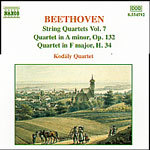
String Quartets Vol 7: Quartet in A min, Op 132 & Quartet in F, H34
 $25.00
Out of Stock
$25.00
Out of Stock6+ weeks add to cart
BEETHOVEN
String Quartets Vol 7: Quartet in A min, Op 132 & Quartet in F, H34
Kodaly Quartet
[ Naxos / CD ]
Release Date: Tuesday 28 June 2005
This item is currently out of stock. It may take 6 or more weeks to obtain from when you place your order as this is a specialist product.
"Philip Fowke plays all "The Kodaly is a very precise and clear reading. The playing is very fine, and the very introspective 'Heiliger Dankgesang' emerges slowly and progresses subtly. ... The Naxos recording has a great transcription by Beethoven of his Piano Sonata No. 9, published in 1802, shortly after his first set of quartets. He disguises the piece's pianistic origins in string quartet clothing resembling the style of the Opus 18 set."
- American Record Guide (Elaine Fine), July-August, 2000
"The Kodaly is a very precise and clear reading. The playing is very fine, and the very introspective 'Heiliger Dankgesang' emerges slowly and progresses subtly. ... The Naxos recording has a great transcription by Beethoven of his Piano Sonata No. 9, published in 1802, shortly after his first set of quartets. He disguises the piece's pianistic origins in string quartet clothing resembling the style of the Opus 18 set."
- American Record Guide (Elaine Fine), July-August, 2000
In 1792 Beethoven left his native city of Bonn to seek his fortune in the imperial capital, Vienna. Five years before he had been sent to Vienna by his patron, the Archbishop of Cologne, for lessons with Mozart, but the illness of his mother had forced his immediate return home. Before long, after his mother's death, he had been obliged to take charge of the welfare of his younger brothers, a task that his father was not competent to discharge.
As a boy Beethoven had had an erratic musical training through his father, a singer in the archiepiscopal musical establishment, later continued on sounder lines. In 1792 he was to take lessons from Haydn, from whom he later claimed to have learned nothing, followed by subsequent study of counterpoint with Albrechtsberger and Italian word-setting with Salieri. Armed with introductions to members of the nobility in Vienna, he soon established himself as a keyboard virtuoso, skilled as a performer and equally adept in the necessary art of improvisation. In the course of time he was to be widely recognised as a figure of remarkable genius and originality. At the same time he became known as a social eccentric, no respecter of persons, his eccentricity all the greater because of increasing deafness, a failing that became evident by the turn of the century. With the patient encouragement of patrons, he directed his attentions largely to composition, developing the inherited classical tradition of Haydn and Mozart and extending its bounds in a way that presented both an example and a challenge to the composers who came after him.
In his sixteen string quartets, the first set of six published in 1801 and the last published in the year of his death, 1827, Beethoven was as innovative as ever, developing and extending a form that seemed already to have reached a height of perfection. The first quartets were followed in 1802 by an F major arrangement of the Piano Sonata in E major, Opus 14, No. 1, for string quartet. The three quartets for the Russian ambassador in Vienna, Count Razumovsky, followed in 1805 and 1806 and Beethoven returned to the form again in 1809 and 1810. It was not until 1823, however, that he resumed his attention to the string quartet in a remarkable final series of works, starting with the String Quartet in E flat major, Opus 127, completed in 1824. This was the first of a group of three quartets commissioned by Prince Nicolas Galitzin, an enthusiastic patron and himself an amateur cellist, in a letter to Beethoven in November 1822. On 25th January the following year Beethoven replied, accepting the commission and asking for a fee of 50 ducats a quartet, pledging himself at the same time to complete the first quartet by February or March at the latest. In the event Galitzin had to wait until March 1825 before he received the first work, after disguising any impatience he may have felt at a delay which he understood as necessary for a genius.
Tracks:
String Quartet No. 15 in A minor, Op. 132
String Quartet in F major, H. 34 (tr. of Piano Sonata in E major, Op. 14, No. 1)


